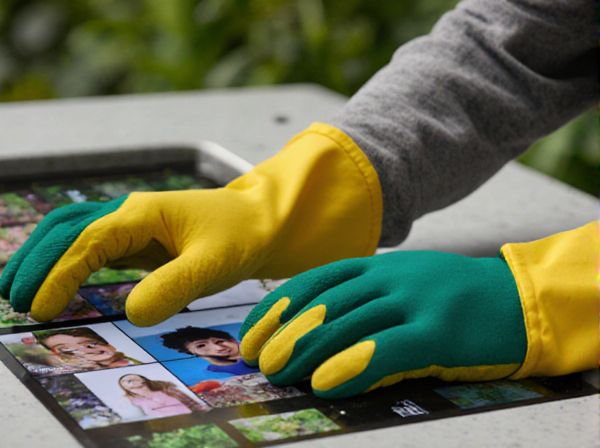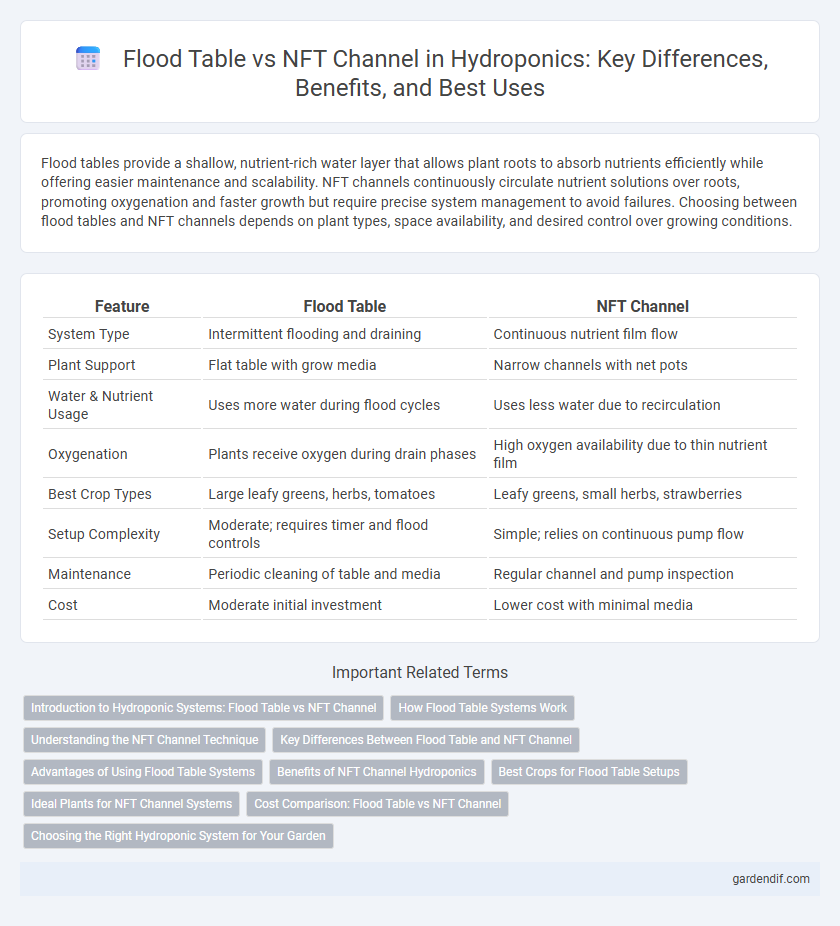
Flood Table vs NFT Channel Illustration
Flood tables provide a shallow, nutrient-rich water layer that allows plant roots to absorb nutrients efficiently while offering easier maintenance and scalability. NFT channels continuously circulate nutrient solutions over roots, promoting oxygenation and faster growth but require precise system management to avoid failures. Choosing between flood tables and NFT channels depends on plant types, space availability, and desired control over growing conditions.
Table of Comparison
| Feature | Flood Table | NFT Channel |
|---|---|---|
| System Type | Intermittent flooding and draining | Continuous nutrient film flow |
| Plant Support | Flat table with grow media | Narrow channels with net pots |
| Water & Nutrient Usage | Uses more water during flood cycles | Uses less water due to recirculation |
| Oxygenation | Plants receive oxygen during drain phases | High oxygen availability due to thin nutrient film |
| Best Crop Types | Large leafy greens, herbs, tomatoes | Leafy greens, small herbs, strawberries |
| Setup Complexity | Moderate; requires timer and flood controls | Simple; relies on continuous pump flow |
| Maintenance | Periodic cleaning of table and media | Regular channel and pump inspection |
| Cost | Moderate initial investment | Lower cost with minimal media |
Introduction to Hydroponic Systems: Flood Table vs NFT Channel
Flood table hydroponic systems utilize periodic flooding and draining to deliver nutrient solutions to plant roots, promoting oxygenation and efficient nutrient absorption. NFT (Nutrient Film Technique) channels maintain a consistent, thin film of nutrient-rich water flowing over roots within sloped channels, optimizing water and nutrient recirculation. Both systems offer scalable solutions for soilless cultivation, with flood tables being ideal for larger, leafy greens and NFT channels suited for smaller, fast-growing plants.
How Flood Table Systems Work
Flood table systems in hydroponics operate by periodically flooding a shallow growing bed with nutrient-rich water, allowing plant roots to absorb moisture and nutrients before the water drains away. This method ensures consistent root oxygenation and nutrient delivery, promoting healthy plant growth and minimizing water waste. Unlike NFT channels that rely on continuous water flow, flood tables cycle between wet and dry phases, supporting a wide range of crop types with variable root structures.
Understanding the NFT Channel Technique
The NFT (Nutrient Film Technique) channel system continuously circulates a thin layer of nutrient-rich water over plant roots, offering efficient oxygenation and nutrient uptake compared to the periodic flooding in flood table setups. NFT channels require precise slope and flow rate control to prevent water stagnation and ensure uniform nutrient delivery across all plants. This technique excels in handling lightweight crops like leafy greens, optimizing water usage and promoting rapid growth with minimal substrate.
Key Differences Between Flood Table and NFT Channel
Flood tables use a shallow water layer to flood and drain plant roots periodically, promoting aeration and nutrient absorption, while NFT (Nutrient Film Technique) channels maintain a continuous, thin film of nutrient solution flowing over the roots for constant hydration. Flood tables are suitable for larger plants with extensive root systems due to their ability to control water levels, whereas NFT channels are ideal for smaller, fast-growing crops like leafy greens because of efficient nutrient delivery and oxygen availability. The key difference lies in water delivery frequency and root exposure, influencing plant type compatibility and system maintenance complexity.
Advantages of Using Flood Table Systems
Flood table systems offer superior root oxygenation and nutrient absorption by periodically flooding and draining the grow bed, promoting healthier plant growth compared to continuous flow NFT channels. These systems support a wider variety of crops, including larger plants that require more growing medium and stability, which NFT channels often cannot accommodate. Flood tables also reduce the risk of clogging and nutrient solution imbalance, resulting in more consistent crop yields.
Benefits of NFT Channel Hydroponics
NFT Channel hydroponics offers superior nutrient distribution by continuously circulating a thin film of nutrient solution over the plant roots, promoting oxygenation and reducing water waste. This method enhances root health and growth speed compared to flood tables, which periodically flood and drain the root zone, leading to less consistent nutrient exposure. The lightweight design of NFT channels allows for greater crop density and easier scalability in commercial hydroponic systems.
Best Crops for Flood Table Setups
Flood Table systems excel in growing leafy greens, herbs, and root vegetables due to their uniform water distribution and nutrient availability. Crops like lettuce, spinach, kale, basil, and strawberries thrive in flood tables, benefiting from consistent moisture and aeration. Compared to NFT channels, flood tables are better suited for larger or heavier plants that require stable support and higher nutrient retention.
Ideal Plants for NFT Channel Systems
NFT Channel systems are ideal for growing small, fast-growing plants such as leafy greens like lettuce, spinach, and arugula due to their continuous nutrient flow and aeration. These channels provide optimal oxygen and nutrient delivery, supporting delicate root systems and preventing waterlogging common in heavier plants. Compared to Flood Table systems, NFT Channels excel in space efficiency and precise nutrient management for herbs and microgreens.
Cost Comparison: Flood Table vs NFT Channel
Flood tables typically have higher initial setup costs due to larger infrastructure requirements and water reservoirs, while NFT channels are generally more affordable with simpler, modular designs. Operating costs for flood tables can increase because of higher water usage and energy consumption for pumping, whereas NFT channels use less water and energy, resulting in lower ongoing expenses. Maintenance costs for flood tables may be higher due to the complexity of cleaning and system repairs compared to the streamlined NFT channel systems.
Choosing the Right Hydroponic System for Your Garden
Flood tables provide consistent nutrient delivery by periodically flooding the grow bed, ideal for larger plants requiring stable moisture levels. NFT (Nutrient Film Technique) channels use a continuous thin film of nutrient solution flowing over roots, suited for smaller, fast-growing crops like leafy greens. Selecting between these hydroponic systems depends on plant type, growth stage, space availability, and maintenance preferences to optimize yield and resource efficiency.
Flood Table vs NFT Channel Infographic

 gardendif.com
gardendif.com